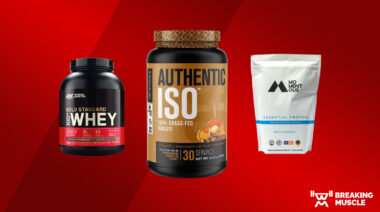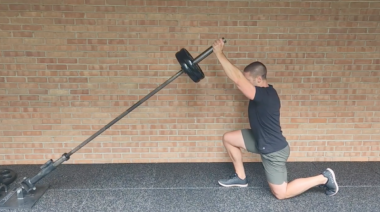You’re in your teens or early twenties. You want to bulk up and gain some muscle. You want to get bigger. Welcome to the club. There are millions of young lads who have that goal. Some of you are insecure about your body. You seek advice to look good. Been there, done that. Take on board a few points from me that will offer some initial perspective.
If you’re young and physically immature, your body is still growing naturally. Your genetics will ultimately dictate how much you can naturally grow. But you can do something to add extra muscle and weight to your frame, beyond natural maturation by itself. I was once there and actually did something about it.
My Story as a Skinny Younger Guy
I was 135lb as a sophomore in high school. I was a scrawny cross-country runner. Ironically, pole vaulting was my specialty. At that point in time, I was oblivious to the realities of proper strength training and sensible nutritional intake. It was 1974, I was sixteen, and I had no concept of proper diet and muscle stimulation basics. Therefore, I continued to train for endurance and failed to eat like someone aspiring to build muscle and scale weight.
That same year my high school installed a Universal multi-station exercise machine. That was epic. At that time we only had plastic weight plates on one-inch barbells and make-shift barbells consisting of concrete-filled cans attached to a one-inch pipe. The exact weight of all devices were unknown, but they offered resistance.
We used the Universal machine religiously after academic commitments were attended to. Without proper instruction, we attempted to train as hard as we knew how to, based on what we knew at the time. In other words, we had no clue what we were doing but we hoped for the best.
Naturally, doing something led to some bodyweight gain. I left high school weighing 150lb and a bit more muscular. In my late teens and early twenties, while at the University of Iowa, I strength trained primarily for improving pole vaulting ability. Again, I lacked minimal knowledge of proper diet for muscle building. However, I continued to bust my butt and reached 170lb by my senior year in college.
A Lack of Fuel
In the summer I worked for the athletic department at the University of Iowa. This entailed manual labor tasks such as painting, grass-cutting, cleaning, etc. I rode my bicycle to work each day and toted a lunch bag containing usually two ham sandwiches and a piece of fruit. At the end of the work-day I would head to the weight room at the old field house and engage in an energy-depleting strength training regimen. Understand my last food intake was about five hours earlier, so I went into these sessions on an empty tank. Again, I had no clue that was not ideal.
Unfortunately, and unknowingly, gains were hard to come by. Really? Heck, I had no clue that being well-fueled prior to a rigorous workout was needed for productive strength training. I had just spent the last five hours performing energy-depleting manual labor tasks and then expected to train like a champion.
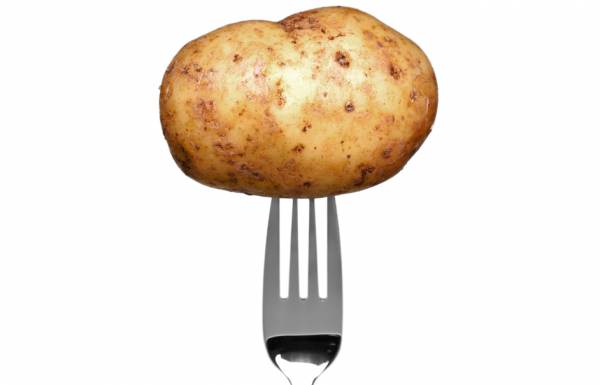
Being the low-budget college student I was, upon completing the session and returning home, my evening food intake was minimal in calories. A portion of mac ‘n cheese, tuna, and a potato. That was usually it. It was insufficient for restoring needed calories to not only to aid recovery, but to also build new muscle mass and add body weight.
The Lessons
If your goal is to build muscle, you’ve got to eat. I’m not talking about a modest breakfast, a couple of ham sandwiches for lunch, and mac ‘n cheese for dinner. You’ll need at least a hearty breakfast (it’s dubbed “break-fast” for a reason), a mid-morning food intake, a sensible lunch, a mid-afternoon feeding, and then an appropriate dinner in the evening. Remember, you’re attempting to build muscle so you need fuel to accomplish that.
In logical fashion, you’ll need to do this:
- Properly stimulate muscle tissue to grow. That is, you’ll need to train hard in the weight room (suggested workouts are forthcoming).
- Following productive workouts, you’ll need to allow time for the results to appear. That is, you’ll need to allow time for growth and strength. Don’t be a bad-ass hero, crush yourself all seven days of a week, and expect that approach will make you bigger. It may work for a few weeks or a month, but eventually your recovery ability will be compromised and you’ll begin to regress.
- Be smart. Hard work is necessary, but allowing recovery time on the biological clock is a must.
The Underrated Gem: The Repetition Range
Progressive training is a hallmark of any productive strength training or muscle building program. It represents the essence of dedicated training. Think about it. If you lift the same amount of resistance for the same number of repetitions (reps) each workout session, you’ll go nowhere. At some point you need to attempt more reps, or more use more resistance. How else will your muscles be challenged to grow?
If you’re seeking direct muscle mass and strength gain increases, you cannot use a random, over-complicated means of achieving that. You want something dead-on and measurable; something that shows that you are improving from workout to workout. Rep ranges are a no-brainer for 95% of the population. They’re so simple to understand.

Here is an example. Rep range ten to fourteen. Your goal in workout one is to reach volitional muscular fatigue with “X” amount of resistance within ten to fourteen reps. Say 200lb was used and twelve perfect reps were performed (a thirteenth rep was unattainable). You would record on the workout recording form “200 x 12”. This is independent on the rep scheme used. That is, whether it’s one set-only workout, the second set of a two-set protocol, or any set on a three-set scheme.
The goal in the forthcoming workout would be to achieve more reps with 200lb because the rep goal in the range is fourteen. If thirteen reps were attained with 200lb, that result would be recorded, indicating progression, and the goal in the next session would be fourteen reps. If fourteen reps were then attained in that training session, it would be recorded thus triggering a resistance increase in the following session because the top end of the rep range was achieved.
The next workout resistance for that set would increase to 210lb with the goal of achieving at least ten reps in the ten to fourteen rep range. If the minimum of ten reps were obtained with 200lb, it would indicate an improved strength level via the progressive nature of the rep range.
The ongoing goal would be to increase the number of reps within the rep range and then increase the amount of resistance when the top end of the range is breached. Think about it. Over time, this approach is a slow-but-sure approach to physiological advancement relative to muscular strength and weight gain.
Three Workouts That Work If You Work
Here are three workout programs that will work if you work. All consist of varied training days, multiple exercises to choose from, and varied sets and repetition ranges.
Twelve-Week, Four-Day Split Routine Workout
Upper body on Monday and Thursday. Lower body on Tuesday and Friday.
Click on screenshot to download.

Twelve-week, Three-Day Total Body Workout
Total body on Monday, Wednesday, and Friday or Tuesday, Thursday, and Saturday.
Click on screenshot to download.
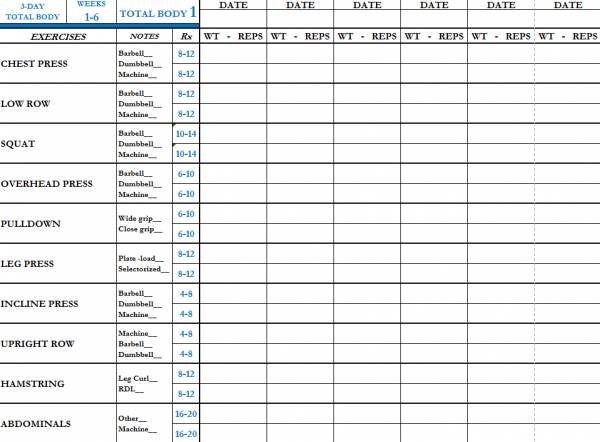
Twelve-Week, Three-Day Total body, Upper Body, Lower Body Workout
Total body on Monday, upper body on Wednesday, and lower body on Friday. Or total body on Wednesday, upper body on Friday, and lower body on Sunday.
Click on screenshot to download.
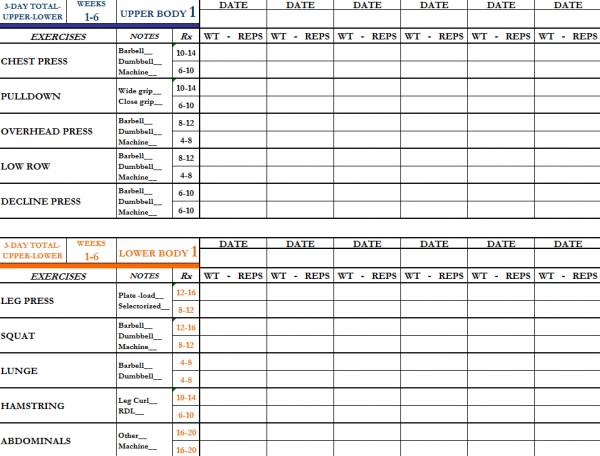
The Take-Home
Choose a viable workout program that fits your schedule and do it religiously. Bust your butt, rest on non-workout days, and eat like you want it.
Make sure you don’t neglect your lower body and back muscles. Following either of the programs above will assure you will work them. The largest muscles in your body, the muscles that if stimulated will better increase your chances of gaining weight, reside in your legs and back. Bicep curls and leg extensions only go so far. Squats, deadlifts, pulldowns, and rows trump those two, relative to potential to grow optimal mass.
Photos courtesy of Shutterstock.

